This article needs additional citations for verification .(June 2012) |

Kloveniersburgwal is an Amsterdam canal flowing south from Nieuwmarkt to the Amstel River on the edge of the medieval city, lying east of the dam in the centre of Amsterdam.
This article needs additional citations for verification .(June 2012) |

Kloveniersburgwal is an Amsterdam canal flowing south from Nieuwmarkt to the Amstel River on the edge of the medieval city, lying east of the dam in the centre of Amsterdam.
The Kloveniersburgwal was dug at the end of the 15th century. The Geldersekade, the Singel and the Kloveniersburgwal together formed the city wall around the city.
After the Nieuwe Gracht (Oude Schans now) was dug and the new city walls were built, Kloveniersburgwal lost its function as a defense canal. The old city wall was taken down and houses were built on it instead. The east side became populated in the 17th century and has a few grand mansions, like the Trippenhuis, now housing the KNAW.
The name 'Kloveniersburgwal' comes from a division of the civic guards, the 'kloveniers', named after the gun the guards were armed with. The kloveniers met at the 'Kloveniersdoelen' next to Swijgh Utrecht on the corner of the Kloveniersburgwal and the Nieuwe Doelenstraat. Later on their groupportrait, the famous painting De Nachtwacht (by Rembrandt), hung in the 'Kloveniersdoelen'. Nowadays, it is exhibited in the Rijksmuseum. Swijgh Utrecht was completely destroyed in 1882; the Doelenhotel was built there instead. [1]
During the Second World War, starting in February 1941, Kloveniersburgwal was the border of the Jewish quarter, segregated by the Germans. In the "Jodenhoek" between Centraal Station, Kloveniersburgwal, Waterlooplein, Valkenburgerstraat, and Prins Hendrikkade, there lived more than 25,000 Jews. [2]
Kloveniersburgwal was popular with administrators at the Dutch East India Company, being close to its center on Oude Hoogstraat and its warehouse.


There are some historically important monuments located at Kloveniersburgwal, for example:

The Vecht is a Rhine branch in the Dutch province of Utrecht. It is sometimes called Utrechtse Vecht to avoid confusion with its Overijssel counterpart. The area along the river is called the Vechtstreek.

The Singel is one of the canals of Amsterdam. The Singel encircled Amsterdam in the Middle Ages, serving as a moat around the city until 1585, when Amsterdam expanded beyond the Singel. The canal runs from the IJ bay, near the Central Station, to the Muntplein square, where it meets the Amstel river. It is now the inner-most canal in Amsterdam's semicircular ring of canals.
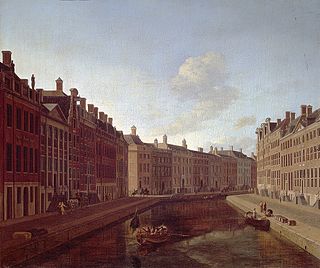
The Herengracht is the second of four Amsterdam canals belonging to the canal belt and lies between the Singel and the Keizersgracht. The Gouden Bocht in particular is known for its large and beautiful canal houses.

The Zwanenburgwal is a canal and street in the center of Amsterdam. During the Dutch Golden Age the canal was home to painter Rembrandt van Rijn, as well as philosopher Spinoza lived here. In 2006 it was voted one of the most beautiful streets in Amsterdam by readers of Het Parool, a local daily newspaper.

Amsterdam, capital of the Netherlands, has more than 100 kilometers (62 mi) of grachten (canals), about 90 islands and 1,500 bridges. The three main canals, dug in the 17th century during the Dutch Golden Age, form concentric belts around the city, known as the Grachtengordel. Alongside the main canals are 1550 monumental buildings. The 17th-century canal ring area, including the Prinsengracht, Keizersgracht, Herengracht and Jordaan, were listed as UNESCO World Heritage Site in 2010, contributing to Amsterdam's fame as the "Venice of the North".

The Oost-Indisch Huis is an early 17th-century building in the centre of Amsterdam. It was the headquarters of the Amsterdam chamber of the Dutch East India Company. It is a listed Dutch national heritage site (rijksmonument).
Gracht is a Dutch word for a canal within a city. Grachten often have a round shape, and form a circle around the city cores in the Netherlands, Belgium, and northern Germany. Outside the Netherlands, the word grachten mostly refers to the city canals of Amsterdam and also Utrecht, Leiden and The Hague. The Koninginnegracht in The Hague was conceived by King Willem I for the promotion of tourism in the early 19th century. Since 2009 the Willemsvaart once more offers tours over this gracht, to Scheveningen, known as "StrandRelax" or "BeachRelax", a unique stretch of sand between The Hague and the sea.

The Waag is a 15th-century building on Nieuwmarkt square in Amsterdam. It was originally a city gate and part of the walls of Amsterdam. Later it served as a guildhall, museum, fire station and anatomical theatre, among other things.

The walls of Amsterdam were built in the Middle Ages to protect the city against attack. The Medieval walls were replaced with a series of bastions in the 17th century. In the 19th century, the walls were torn down and replaced with the Defence Line of Amsterdam, a fortification line which encircled Amsterdam at a distance from the city.
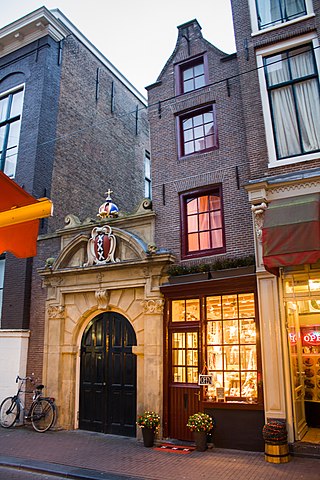
The smallest house in Amsterdam is located at Oude Hoogstraat 22 in the old city center of Amsterdam, next to the Oost-Indisch Huis and the gate to the Walloon Church. The house, by some called the "Smallest house of Europe", is 2.02 meters wide and 5 meters deep. With its distinctive spout gable, this house represents a miniature version of a typical Amsterdam canal house.

The Kloveniersdoelen was a complex of buildings in Amsterdam which served as headquarters and shooting range for the local schutterij. The companies of kloveniers were armed with an early type of musket known as an arquebus, known in Dutch as a bus, haakbus or klover, hence the name kloveniers.

The Handboogdoelen is a building on the Singel canal in Amsterdam, near Koningsplein square. It dates back to the early 16th century and originally served as headquarters and shooting range of the local schutterij. Most of the current building at Singel 421 dates to the 18th century and is part of the main complex of the Amsterdam University Library. The Doelenzaal hall on the ground floor of the building is used for lectures, meetings, receptions and doctoral dissertations. The building has rijksmonument status.
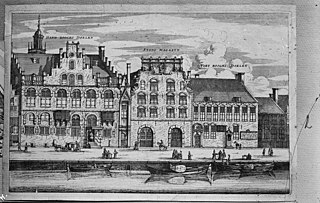
The Voetboogdoelen was a 16th-century building on the Singel canal in Amsterdam, at the corner of Heiligeweg near Koningsplein square, which served as headquarters and shooting range of the local schutterij. Frans Hals painted a group portrait for the Voetboogdoelen, known as the Meagre Company.

The Grimburgwal is a small canal and street in the center of Amsterdam.
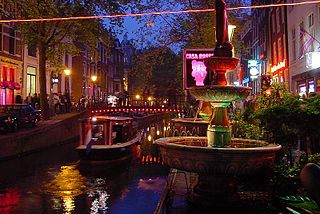
The Oudezijds Achterburgwal, often abbreviated to OZ Achterburgwal, is a street and canal in De Wallen, the red light district in the center of Amsterdam.
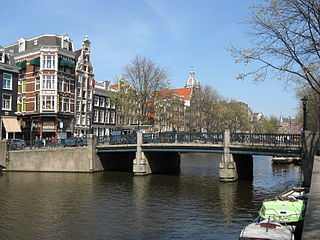
The Geldersekade is a canal and a street in Amsterdam that connects the Nieuwmarkt with the Prins Hendrikkade. The Geldersekade is in the easternmost part of De Wallen, the red light district, and borders Chinatown.

The Oudeschans, or Oude Schans, originally the Nieuwe Gracht, is a wide canal in the eastern part of the inner city of Amsterdam.
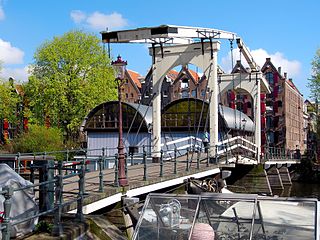
The Prinseneilandsgracht is a canal in the Centrum district of Amsterdam. It runs between Prinseneiland, an artificial island, to the east and the mainland to the west. Until after World War II (1939–45) the canal was bordered almost exclusively by warehouses and factories.

The Spuistraat in downtown Amsterdam connects the Hekelveld to the Spui. It runs roughly north to south, parallel to the Singel and the Nieuwezijds Voorburgwal. At the Royal Palace of Amsterdam, the Spuistraat crosses the Raadhuisstraat and Paleisstraat. Originally the Spuistraat was a canal, the Nieuwezijds Achterburgwal. The canal was filled in in 1867, and the street renamed then.
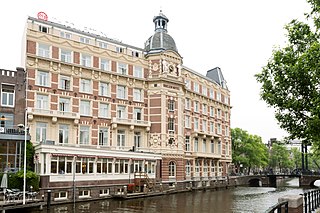
Tivoli Doelen Amsterdam Hotel is a historic hotel in the Binnenstad of Amsterdam, the oldest hotel in the city. It is located on the Binnen-Amstel at the southern end of the Kloveniersburgwal. The entrance is at Nieuwe Doelenstraat 24.